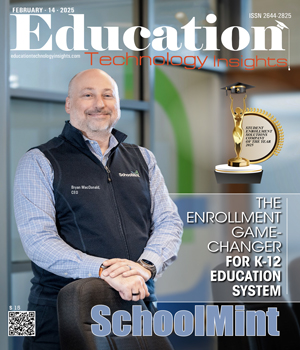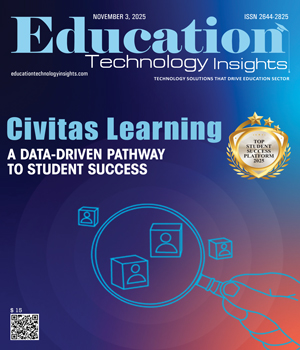THANK YOU FOR SUBSCRIBING
Be first to read the latest tech news, Industry Leader's Insights, and CIO interviews of medium and large enterprises exclusively from Education Technology Insights
Innovating Education through Leadership and Collaboration
Maria Puzziferro, Associate Chief Academic Officer and Vice President, Teaching, Learning and Innovation, University of St. Augustine for Health Sciences
Career Journey and Key Shaping Experiences Maria Puzziferro, Associate Chief Academic Officer and Vice President, Teaching, Learning and Innovation, University of St. Augustine for Health Sciences
Maria Puzziferro, Associate Chief Academic Officer and Vice President, Teaching, Learning and Innovation, University of St. Augustine for Health Sciences
I began my career as a faculty technology coordinator and trainer at St. John’s University in the early 1990s, when learning technologies were emerging. As a young woman charged with fostering technology adoption amongst faculty, I learned that leadership in innovation involves transforming an external vision into a personal aspiration. To achieve the university’s vision of being relevant and competitive during a technological revolution, faculty needed to adopt and integrate technology into their personal teaching practice. I just needed to help them realize why, how, and for whom they wanted to invest the time and energy into learning something new. Thus began real learning for me.
Since then, I've taken on increasingly complex leadership roles, always drawn to opportunities to build, transform, and collaborate on new solutions. In innovation, challenging the status quo is key. While higher education values stability, innovation thrives on disruption and imagination. Success in innovation requires a clear vision, supportive culture, stakeholder engagement, and agile processes that embrace failure and continuous improvement.
Challenges in Developing Faculty Skills Today
One of the most pressing challenges is balancing competing demands on faculty time. Teaching, research, service, administration, and other personal and professional obligations can make it difficult for faculty to prioritize the time needed for continuous skill-building. At the University of St. Augustine for Health Sciences, the Institute for Learning, Innovation, and Faculty Excellence (iLIFE) team addresses this by maintaining a robust library of training offerings in multiple formats, including on-demand video and asynchronous micro-credentials.
“Innovation in higher education thrives on collaboration, clear vision, and a supportive culture. By balancing academic standards with creativity, fostering continuous faculty development, and embracing change, leaders can drive meaningful transformation that benefits students and institutions alike”
The second most pressing challenge is keeping pace with rapid changes in education, from emerging technologies to evolving student expectations. While faculties are eager to innovate, the abundance of new tools can be overwhelming. To support them, the University of St. Augustine for Health Sciences continuously tracks trends and updates its professional development resources.
Finally, fostering a growth mindset is key. Faculties are more open to experimenting with new methods when a supportive culture embraces new ideas and celebrates learning from mistakes. Our Innovation and Technology Committee invites faculty to apply for grants to test innovations in teaching and learning, and this culture of experimentation is instrumental in helping faculty continuously adapt and succeed in today’s dynamic educational environment.
Keeping Teams Motivated During Initiatives
Keeping teams motivated and aligned during extended initiatives requires a shared vision, clear goals, accountability, and a supportive team culture.
a. Vision: We maintain a shared vision and vocabulary aligned with our mission. Losing sight of the "why" weakens the "what," causing projects to lose momentum or fail.
b. Clear, Documented Goals: We set clear, shared, and achievable goals, using streamlined tools to manage complex initiatives effectively.
c. Accountability: Assigning accountability keeps individuals connected, showing how their work contributes and sustains long-term commitment.
d. Consistent Communication: Ongoing development meetings build trust, ensure alignment, solve problems, and provide opportunities to celebrate achievements and support the team.
e. Supportive Team Culture: Intimidation does not inspire human productivity. We are supportive and kind but direct.
Balancing Academic Standards and Innovation
Standardization is essential in education. Standards provide a) clear objectives that align with accreditation and regulatory standards, b) consistent instructional methods that ensure all students receive consistent quality and quantity of instruction, and c) valid and reliable assessments that allow direct student comparison to ensure learning and curricular effectiveness. However, creativity and innovation in curriculum design and instruction allow for personalization that can enhance teaching and learning, especially as our faculty and student populations continue to diversify.
To define the balance between standardization and creativity, we frame the relationship between the “what” and the “how”. The curriculum is the “what,” and the standard does not change without a formal process. Instructional methods are the “how,” where faculty can utilize their pedagogical creativity and selected technology innovations to personalize and enhance instruction to achieve curriculum objectives.
Anticipated Shifts in Higher Education Landscape
The University of St. Augustine for Health Sciences is preparing for the rise of AI by upskilling faculty through various learning opportunities at our Institute for Learning, Innovation, and Faculty Excellence (iLIFE).
The biggest shift is evolving learning needs, with more nontraditional students seeking flexible, relevant programs. To support them, we’re expanding delivery options to accommodate diverse learning styles, responsibilities, and relocation efforts.
Additionally, there’s growing demand for interdisciplinary and experiential learning, with students seeking real-world problem-solving opportunities. We integrate dynamic experiences like inter-professional learning, pro bono clinics, and simulations into the curriculum to help students collaborate and address issues beyond the classroom.
Advice for Emerging Higher Education Leaders
As an innovator, it’s essential to develop interpersonal skills, as the work is more complex than simply leading exciting initiatives.
Second, understand what innovation is and isn’t. Innovation is a collaborative process of creating and implementing novel ideas that solve real problems. To start the innovation process, stakeholders must first agree that there is a problem to solve.
Third, innovation thrives on collaboration and iteration. An idea that starts clear may become complex, requiring the innovator to shift from visionary to facilitator—refining insights, staying problem-focused, and guiding the team from analysis to action.
Fourth, effective communication is key—lead with a clear vision and language that resonates. Avoid buzzwords; ensure your message feels natural so stakeholders can internalize, align with, and articulate it.
Finally, pilot and iterate—start small, gather feedback, and refine before scaling. This approach minimizes risk, upholds standards, and ensures controlled, well-managed change.
Weekly Brief
Featured Vendor
Read Also
Goldilocks Regulation
Beyond the Quiz: Redefining Competence in eLearning
Beyond Theory and Into Monday Morning: Enhancing Graduate Programs for Teachers
Safeguarding Students in the Age of Deepfakes: An Educational Imperative
Delivering Excellence in Education through Transformative School Leadership
Curriculum Innovation for Student Success and Institutional Growth

I agree We use cookies on this website to enhance your user experience. By clicking any link on this page you are giving your consent for us to set cookies. More info















-(2)-1.jpg)













